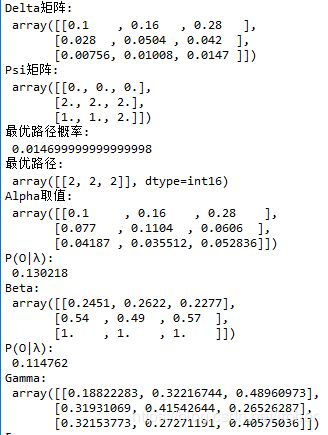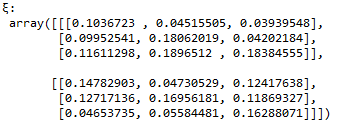隐马尔可夫模型 HMM 的python实现(李航—统计学习方法)
文章目录
- 1、代码
- 2、运行结果
- 3、参考文献
借助此代码,帮助自己理解李航《统计学习方法》书本的公式。
1、代码
# -*- coding: utf-8 -*-
"""
Created on Tue Sep 3 13:35:13 2019
@author: chf
"""
import numpy as np
'''
初始化数据集
Ann 表示状态转移概率矩阵,
Bnm 表示观测概率矩阵,
Pi 表示初始状态概率向量
O是对应的观测序列
N 表示可能的状态数
M 表示可能的观测数
'''
class HMM:
def __init__(self, Ann, Bnm, Pi, O):
self.A = np.array(Ann, np.float)
self.B = np.array(Bnm, np.float)
self.Pi = np.array(Pi, np.float)
self.O = np.array(O)
self.N = self.A.shape[0] #N = A.shape[0]为数组A的行数,
self.M = self.B.shape[1] #M = B.shape[1]为数组O的列数
def viterbi(self):
# given O,lambda .finding I
T = self.O.shape[1]
I = np.zeros((1, T), np.int16)
delta = np.zeros((T, self.N), np.float)
psi = np.zeros((T, self.N), np.float)
for i in range(self.N):
delta[0, i] = self.Pi[0, i] * self.B[i, O[0, 0]-1]
psi[0, i] = 0
for t in range(1, T):
for i in range(self.N):
delta[t, i] = self.B[i, O[0, t]-1] *np.array( [delta[t-1,j] * self.A[j,i]
for j in range(self.N)] ).max()
psi[t,i] = np.array( [delta[t-1,j] * self.A[j,i]
for j in range(self.N)] ).argmax()
print("Delta矩阵: \n %r" % delta)
print("Psi矩阵: \n %r" % psi)
P_best = delta[T-1, :].max()
# print(P_T)
I[0, T-1] = delta[T-1, :].argmax()
#
for t in range(T-2, -1, -1):
I[0, t] = psi[t+1, I[0, t+1]]
print("最优路径概率: \n %r" % P_best)
print("最优路径: \n %r" % I)
return I
def forward(self):
T = self.O.shape[1]
alpha = np.zeros((T, self.N), np.float)
for i in range(self.N):
alpha[0,i] = self.Pi[0, i] * self.B[i, self.O[0, 0] - 1]
for t in range(T-1):
for i in range(self.N):
summation = 0 # for every i 'summation' should reset to '0'
for j in range(self.N):
summation += alpha[t,j] * self.A[j,i]
alpha[t+1, i] = summation * self.B[i, self.O[0, t+1] - 1]
summation = 0.0
for i in range(self.N):
summation += alpha[T-1, i]
Polambda = summation
print("Alpha取值: \n %r" % alpha)
print("P(O|λ): \n %r" % Polambda)
return Polambda,alpha
def backward(self):
T = self.O.shape[1]
beta = np.zeros((T, self.N), np.float)
for i in range(self.N):
beta[T-1, i] = 1.0
for t in range(T-2,-1,-1):
for i in range(self.N):
summation = 0.0 # for every i 'summation' should reset to '0'
for j in range(self.N):
summation += self.A[i,j] * self.B[j, self.O[0, t+1] - 1] * beta[t+1,j]
beta[t,i] = summation
Polambda = 0.0
for i in range(self.N):
Polambda += self.Pi[0, i] * self.B[i, self.O[0, 0]] * beta[0, i]
print("Beta: \n %r" % beta)
print("P(O|λ): \n %r" % Polambda)
return Polambda, beta
def compute_gamma(self,alpha,beta):
T = self.O.shape[1]
gamma = np.zeros((T, self.N), np.float) # the probability of Ot=q
for t in range(T):
for i in range(self.N):
gamma[t, i] = alpha[t,i] * beta[t,i] / sum(
alpha[t,j] * beta[t,j] for j in range(self.N) )
print("Gamma: \n %r" % gamma)
return gamma
def compute_xi(self,alpha,beta):
T = self.O.shape[1]
xi = np.zeros((T-1, self.N, self.N), np.float) # note that: not T
for t in range(T-1): # note: not T
for i in range(self.N):
for j in range(self.N):
numerator = alpha[t,i] * self.A[i,j] * self.B[j,self.O[0, t+1] -1] * beta[t+1,j]
# the multiply term below should not be replaced by 'nummerator',
# since the 'i,j' in 'numerator' are fixed.
# In addition, should not use 'i,j' below, to avoid error and confusion.
denominator = sum( sum(
alpha[t,i1] * self.A[i1,j1] * self.B[j1,self.O[0, t+1] -1] * beta[t+1,j1]
for j1 in range(self.N) ) # the second sum
for i1 in range(self.N) ) # the first sum
xi[t,i,j] = numerator / denominator
print("ξ: \n %r" % xi)
return xi
#输入格式如下:
A = np.array([[.5,.2,.3],[.3,.5,.2],[.2,.3,.5]])
B = np.array([[.5,.5],[.4,.6],[.7,.3]])
Pi = np.array([[.2,.4,.4]])
O = np.array([[1,2,1]])
Hmm = HMM(A, B, Pi, O)
Hmm.viterbi()
Polambda1,alpha = Hmm.forward()
Polambda2, beta = Hmm.backward()
Hmm.compute_gamma(alpha,beta)
Hmm.compute_xi(alpha,beta)
2、运行结果
运行环境为Spyder(python 3.7),代码直接复制,运行即可


3、参考文献
https://www.cnblogs.com/d-roger/articles/5719979.html